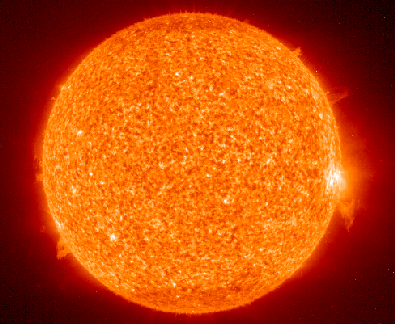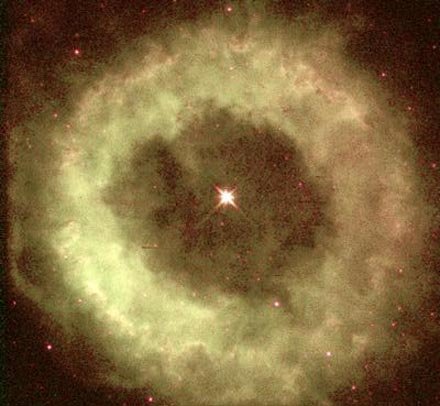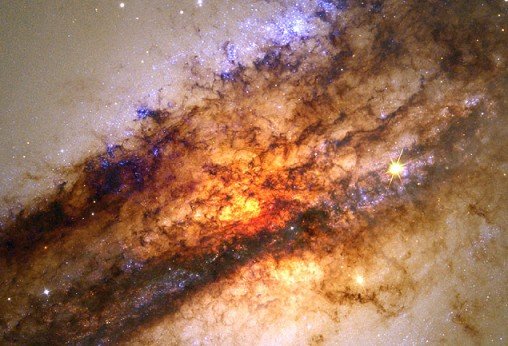#1060 Comet Stonehouse May 14, 1998

“Comets move against a field of background stars. Their apparent motion is slow but carefull tracking reveals their orbits, allowing these visitors to the inner solar system to be identified as old or new acquaintances. Recently a new comet, designated 1998 H1, was discovered by observer Patrick L. Stonehouse of Wolverine, Michigan, USA, and announced on April 26. At 10th magnitude, comet Stonehouse is too faint to be seen by the unaided eye, but it is presently a popular object for telescope-equipped comet watchers. This false color picture of comet Stonehouse was taken on May 1st at Limber Observatory and is a composite of 8 exposures each 60 seconds long. The sequence of exposures was made with the telescope following the background stars. The individual pictures were then aligned on the comet and added together. Because of the comet's relative motion, the combined multiple-exposure shows trails of progressively offset star images but nicely captures the comet's coma and faint, tenuous tail."
Copyright: D. McDavidLimber Observatory
#1061 TRACE and the Active Sun May 15, 1998

“This dramatic high resolution picture looking across the edge of the Sun was taken April 24th by a telescope on board the newly launched Transition Region and Coronal Explorer (TRACE) satellite. It shows graceful arcs of intensely hot gas suspended in powerful looping magnetic fields which soar above a solar active region. The colorized image was made in the extreme ultraviolet light radiated by highly ionized Iron atoms. With a temperature of a mere 6,000 degrees Celsius, the sun's surface is relatively cool and dark at these wavelengths, but the million degree hot plasma loops glow strongly! Such TRACE images follow the plasma and magnetic structures arising from the surface of the sun as they merge with the tenuous, hot solar Corona or outer atmosphere. By operating the TRACE instruments during the Sun's increasingly active phase, scientists hope to explore the connections between complex solar magnetic fields and potentially hazardous solar eruptions."
Copyright: Public domain
#1062 Helios Helium May 16, 1998

“This image of the relatively quiet Sun was made using ultraviolet light emitted by ionized Helium atoms in the Solar chromosphere. Helium was first discovered in the Sun in 1868, its name fittingly derived from from the Greek word Helios, meaning Sun. Credit for the discovery goes to astronomer Joseph Norman Lockyer (born May 17, 1836). Lockyer relied on a then recently developed technique of spectroscopy, dissecting sunlight into a spectrum, and the idea that each element produces a characteristic spectral pattern of bright lines. He noticed a yellow line in a solar spectrum made during an eclipse which could not be accounted for by elements known on Earth. Almost 27 years later terrestrial Helium was finally discovered when the spectrum of a Helium bearing mineral of Uranium provided an exact match to the previously detected element of the Sun. Helium is now known to be the second most abundant element (after Hydrogen) in the Universe."
Copyright: Public domain
#1063 Our Solar System from Voyager May 17, 1998

“After taking spectacular pictures of our Solar System's outer planets, Voyager 1 looked back at six planets to take our Solar System's first family portrait. Here Venus, Earth, Jupiter, Saturn, Uranus, and Neptune, were all visible across the sky. Each, however, was now just a small speck of light, dimmer than many of the stars in the sky. Voyager 1 is only one of four human-made objects to leave our Solar System, the other three being Voyager 2, and Pioneer 10 and Pioneer 11."
Copyright: Public domain
#1064 NGC 6369: A Donut Shaped Nebula May 18, 1998

“Why isn't the star in the center of the nebula? NGC 6369 appears to be a fairly ordinary planetary nebula. It can be seen with a good telescope in the constellation of Ophiuchus. The gas expelled by the central star is bunched in the shape of a donut or cylinder. During the planetary nebula phase, the central star sheds its outer atmosphere as it is evolving to become a white dwarf star. The above image was taken with the Hubble Space Telescope. A closer look at NGC 6369 indicates that the central star is closer to a dimmer edge of the nebula than to the opposing brighter edge."
Copyright: Public domain
#1065 Apollo 11: Onto a New World May 19, 1998

“A human first set foot on another world on July 20, 1969. This world was Earth's own Moon. Pictured above is Neil Armstrong preparing to take the historic first step. On the way down the Lunar Module ladder, Armstrong released equipment which included the television camera that recorded this fuzzy image. Pictures and voice transmissions were broadcast live to an estimated world wide audience of one billion people. The Apollo Moon landings have since been described as the greatest technological achievement the world has known."
Copyright: Public domain
#1066 Discovery Image: Comet SOHO (1998 J1) May 20, 1998

“Staring at the Sun from a vantage point in space (Kids, don't try this at home!), the Solar and Heliospheric Observatory (SOHO) has enabled the discovery of much about our closest star. It has also been used to discover about 50 comets. While not competing with Hale-Bopp, one of SOHO's recently discovered comets has proved to be bright enough to see with the unaided eye. The May 4th discovery image is shown above with an enlarged inset of the comet. This colorized image is from SOHO's solar coronagraph (LASCO) which views the region around the Sun by blocking out the overwhelming sunlight with an occulting disk. The disk is visible near the bottom left, with the Sun's size and position indicated by the white circle. Bright solar wind regions can also be seen along with the the planet Mars and a background of stars. The comet itself is just entering the field of view at the upper right. Observers report that Comet SOHO (1998 J1) has now been seen low in the western sky following sunset and is moving south and east becoming more visible as this month progresses, particularly from the Southern Hemisphere."
Copyright: Public domain
#1067 Bright Comet SOHO May 21, 1998

“Discovered this month with an orbiting solar observatory, bright Comet SOHO has now emerged from the Sun's glare. This telephoto picture of the new naked-eye comet was taken by astrophotographer Michael Horn after sunset in the western twilight above Lake Samsonvale, Brisbane, Australia on May 18. The comet is seen in the constellation Orion. Its long lovely tail stretches nearly 5 degrees to the bright star Bellatrix, near the top of the image. For Southern Hemisphere comet watchers, views of Comet SOHO (1998J1) will improve as this month draws to a close and the comet climbs to the south and east on its journey outward bound. In February 1999, NASA plans to launch the Stardust mission to fly close to a comet and return samples of dust from a comet's tail."
Copyright: Michael Horn
#1068 The Center of Centaurus A May 22, 1998

“A fantastic jumble of young blue star clusters, gigantic glowing gas clouds, and imposing dark dust lanes surrounds the central region of the active galaxy Centaurus A. This mosaic of Hubble Space Telescope images taken in blue, green, and red light has been processed to present a natural color picture of this cosmic maelstrom. Infrared images from the Hubble have also shown that hidden at the center of this activity are what seem to be disks of matter spiraling into a black hole with a billion times the mass of the Sun! Centaurus A itself is apparently the result of a collision of two galaxies and the left over debris is steadily being consumed by the black hole. Astronomers believe that such black hole "central engines" generate the radio, X-ray, and gamma-ray energy radiated by Centaurus A and other active galaxies. But for an active galaxy Centaurus A is close, a mere 10 million light-years away, and is a relatively convenient laboratory for exploring these powerful sources of energy."
Copyright: Public domain
Upvote! Resteem! Comment! As you like it! Thank you for attention!